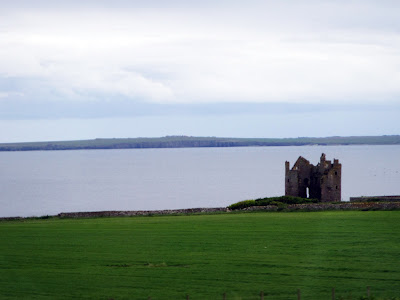Today was another early morning, as I had used Viator to book a 13-14 hour tour to the Orkney Islands from Inverness.
The Orkney Islands are often thought of as part of Scotland, but that isn't technically correct. They are part of the United Kingdom just like England, Wales, Scotland, and the Shetland Islands, but the Orcadians don't want to be called Scottish any more than the Scottish or Welsh want to be called English. But, like Scotland, the Orcadians are bagpipe playing, kilt-wearing people.
Also, the Orkney newspaper was proud to publish an article that proclaimed Groundskeeper Willie from the Simpsons as a Kirkwallian member of the Orkney Islands.
This tour was long. We had to catch a bus at 7:30am and drive from Inverness to John O'Groats. I slept off and on the entire way.
Kris tells me the lady tour guide on the bus had a lot of interesting things to say about the passing landscape and history of the region.
We had about 20 minutes at John O'Groats before catching a ferry to Burwick in South Ronaldsay of the Orkney Islands. The Pentland Firth meets the North Sea at the bottom of Orkney and the waters are rough. I was lucky enough to sleep through most of this too.
The bus driver/tour guide on the Orkney Islands was a witty guy with a lot of tattoos wearing a short sleeved shirt. I quite enjoyed his banter.
I didn't even fall asleep quite as often as I usually do.
The lower portion of the Orkney Islands are mostly connected with bridges called the Churchill Barriers. During WWII, many Italian prisoners of war were brought to Orkney to construct the Churchill Barriers over which roads were eventually constructed. One minute the POWs were in Africa...the next Orkney Island, the sunshine capital of the world (as the tour guide joked). The barriers were primarily built as naval defenses to protect the waters at Scapa Flow.
We drove over several of the barriers, around which we saw several shipwrecks.
 |
| Churchill Barrier |
The Italian POWs were in the Orkney Isles for a long while. They got married and made lives on the islands. During their stay, they asked if they could build a chapel. They were granted this request provided that they get all of the materials themselves by borrowing them. They were provided a lot of cement, which was in ample supply.
Using bits of borrowed paint and other items, they constructed a beautiful chapel. They were so skilled with painting, they honestly made this concrete building look like it was constructed with marble, brick, stone, and wood. They painted regular glass to look like stained glass. Super impressive.
We got to stop around for a look inside and outside. They even painted a statue.
There were a few doggies on our tour too.
We stopped for an hour in Kirkwall and wandered about the town. Being it was Sunday, most things were closed.
 |
| Tree in the middle of the road - and me looking at postcards. |
 |
| We were a bit too cold for ice cream. |
We decided to get lunch at The Reel. I got a tasty panini made of brie, grapes, and apples. Yum!
 |
| I could not figure out how to make the contraption on the right work. |
The majority of our time was spent at Skara Brae and the Skaill House. Skara Brae is a large stone-built Neolithic settlement consisting of ten clustered houses. These homes were occupied from roughly 3180 BC – 2500 BC. This is before the pyramids. The strangest part is that nobody knows what happened to the occupants of Skara Brae.
Skara Brae was discovered in part by a great storm in 1850 and in part by the lord of the Skaill House, William Watt.
Because of the protection offered by the sand that covered Skara Brae for 4,000 years, the buildings and their contents are incredibly well-preserved. If interested, the Orkney Jar website offers a lot of information about Skara Brae.
The Skaill House had some strange and beautiful things.
Afterward, we were on to the Ring of Brodgar (2500 BC), another stone circle. (Kris and I have never spent so much time around rocks.) There are currently 27 stones left in the Ring of Brodgar, thought it is thought there were originally 60 standing.
 |
| Oops...Kris seems to have knocked one over. |
The Ring of Brodgar is the third largest stone circle in the UK. The first is Avebury, which we visited last year.
It's due to Skara Brae, the Ring of Brodgar, and Maeshowe that Orkney has been declared a UNESCO World Heritage location. We didn't have the time (or reservations) to go to Maeshowe unfortunately. Maybe we'll get back one day. You really need more than one day to see this awesome island.
There are few places in the world where you can see so much evidence of neolithic life.
Our six hours on Orkney passed too quickly. We were quickly back on the ferry then back on the bus. During the bus ride, we were given sandwiches we had ordered during the morning ride.
I didn't sleep on the ride back. Kris and I worked on photo editing and blog posts before going back to the B&B.


- Posted using BlogPress from my iPad








































No comments:
Post a Comment